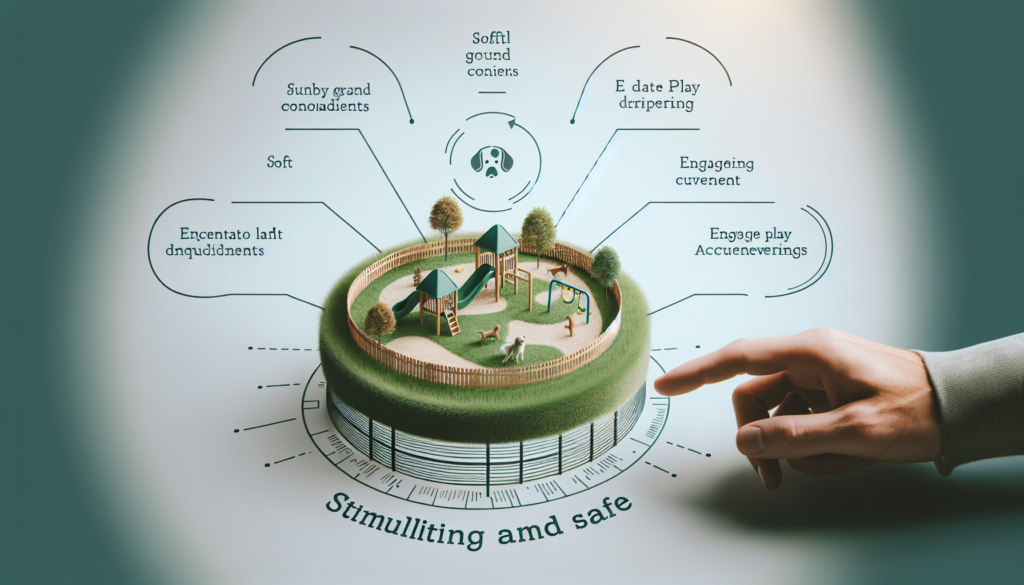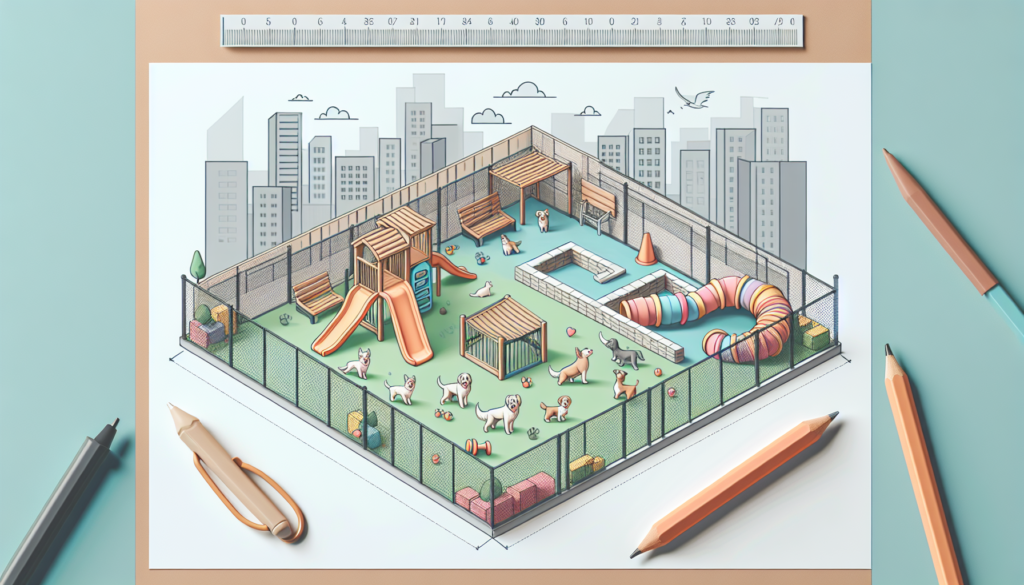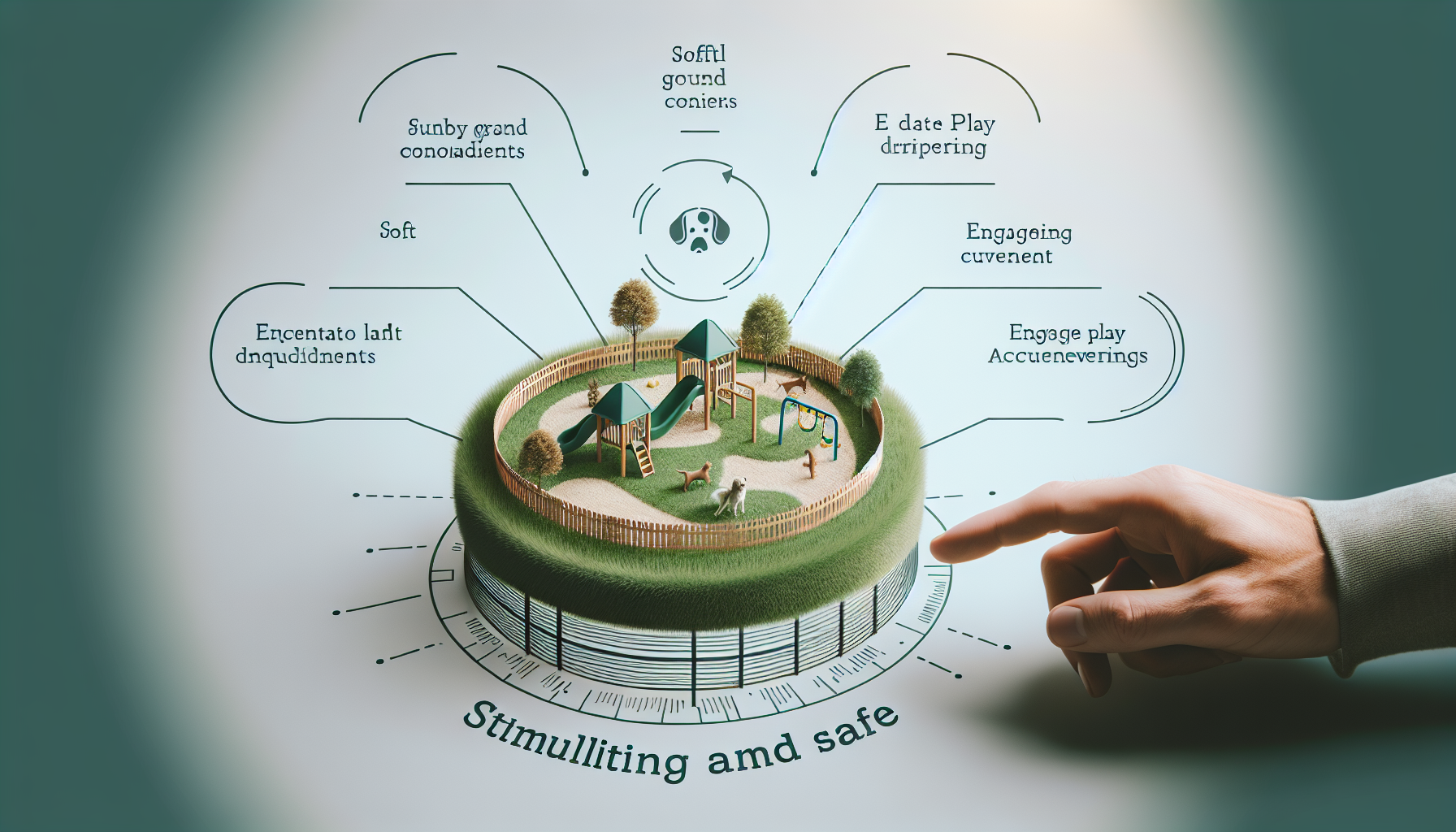You know how important it is to provide a safe and stimulating environment for your furry friend to play and roam freely. Dogs need space to run, play, and socialize, but it’s essential that their play area is secure and promotes their overall well-being. In this article, we will explore the key elements in creating a dog play area that ensures safety and excitement for your beloved pet. From choosing the right fencing to incorporating interactive toys and sensory elements, you’ll discover everything you need to transform your yard into a haven for your four-legged companion. So grab your leash and let’s embark on this journey of crafting the perfect dog play area together!

Designing the Play Area
When designing a dog play area, it’s important to consider various factors to ensure the safety and enjoyment of the dogs. One of the first decisions to make is choosing the location for the play area. Ideally, it should be easily accessible for both dogs and their owners. It should also be away from busy roads or any other potential sources of danger. Additionally, taking into account noise levels and nearby distractions can contribute to creating a calm and enjoyable environment for the dogs.
Determining the size of the play area is another crucial aspect of the design. The size should be suitable for the number of dogs anticipated to use the space simultaneously. It’s important to provide enough room for the dogs to run and play comfortably without feeling cramped or overcrowded. Considering the breed and energy levels of the dogs that will be using the play area can help determine an appropriate size.
Fencing and boundaries play a vital role in ensuring the safety and security of the play area. The fencing should be sturdy and tall enough to prevent dogs from jumping over and escaping. It’s crucial to consider the different sizes and breeds of dogs that will be using the play area when choosing the appropriate height for the fence. Additionally, the boundaries should be clearly marked to prevent any confusion or potential conflicts between dogs.
Creating a Safe Environment
When it comes to creating a safe environment for dogs in the play area, it’s important to remove any potential hazards. This includes removing any sharp objects, toxic plants, or chemicals that could harm the dogs. Regular inspection and maintenance should be carried out to ensure the area remains hazard-free.
Providing shade and shelter is also essential for the comfort and well-being of the dogs. Dogs can easily overheat, especially during hot summer months, so it’s crucial to offer shaded areas where they can rest and cool down. Additionally, having sheltered areas can protect the dogs from rain or extreme weather conditions, allowing them to still enjoy their playtime regardless of the weather.
Proper drainage is an often overlooked yet important aspect of creating a safe environment. Ensuring proper drainage prevents pooling water, which can become a breeding ground for bacteria and pose health risks for the dogs. It’s important to have sloping or graded surfaces that allow water to flow away from the play area, preventing any potential flooding or muddy conditions.
Choosing Appropriate Flooring
Choosing the right flooring for the dog play area is crucial, as it can impact the safety and comfort of the dogs. Grass and natural surfaces, such as turf or soil, can provide a soft and inviting surface for dogs to play on. However, it’s important to maintain these surfaces regularly to avoid overgrowth or potential hazards, such as holes or sharp objects hidden in the grass.
Artificial turf is another option that provides a surface similar to natural grass, but with the added benefit of being low maintenance. It can withstand heavy use and is easy to clean, making it a popular choice for many dog play areas. However, it’s important to choose artificial turf specifically designed for dogs to ensure it is safe and non-toxic.
Gravel or sand can also be used as flooring options, providing a different texture and sensory experience for the dogs. However, it’s important to ensure that the gravel or sand used is dog-friendly and won’t cause any discomfort or injury to the dogs’ paws. Regular maintenance and cleaning are necessary to keep these surfaces free of debris and prevent any potential hazards.
Including Engaging Structures
To keep the dogs active and stimulated, it’s important to include engaging structures within the play area. Agility equipment, such as ramps, hurdles, and tunnels, provides dogs with opportunities for exercise and mental stimulation. These structures can help dogs develop their coordination, balance, and problem-solving skills while having fun.
Tunnels and crawl spaces are also popular additions to dog play areas. Dogs love to explore and navigate through tunnels, simulating natural behaviors like hunting and hiding. These structures offer a sense of excitement and adventure, keeping the dogs engaged and entertained for hours.
Obstacle courses are another great way to challenge dogs physically and mentally. Incorporating jumps, weave poles, and balance beams can create a fun and challenging environment for the dogs. The obstacle course can be designed to cater to different skill levels, allowing dogs of all abilities to participate and enjoy.

Adding Enrichment Activities
Enrichment activities are essential for keeping dogs mentally stimulated and preventing boredom in the play area. Interactive toys and puzzles can provide mental challenges and offer rewards when successfully completed. These toys can include treat-dispensing puzzles or toys that require dogs to solve a problem to access the treat. By engaging their minds, these activities help keep dogs entertained and content.
Scent and sniffing areas are another great way to provide enrichment for dogs. By creating areas where dogs can explore different scents and engage their sense of smell, they are given a chance to use their natural instincts and mental capabilities. Hiding treats or toys in these areas can further enhance the dogs’ enjoyment and cognitive abilities.
Food dispensing stations can also be incorporated into the play area to provide additional enrichment. This can include interactive feeding puzzles or timed-release treat dispensers. These stations encourage dogs to actively engage with their food, promoting mental stimulation and extending the duration of their playtime.
Ensuring Adequate Supervision
Proper supervision is crucial to ensure the safety and well-being of the dogs in the play area. Having a sufficient number of trained staff members present at all times is essential to monitor the dogs’ behavior and intervene if necessary. This ensures that any potential conflicts or aggressive behavior can be addressed promptly, preventing any harm to the dogs or their owners.
The use of surveillance cameras can also provide an additional layer of supervision. Cameras allow staff members to monitor the play area from various angles and quickly identify any potential issues or concerns. This can help ensure a safe and secure environment for the dogs, as well as provide peace of mind for their owners.
Establishing rules and guidelines for visitors to the play area is another important aspect of ensuring adequate supervision. Clear instructions regarding appropriate behavior, dog vaccination requirements, and rules for interactions between dogs should be posted and communicated to all visitors. This helps maintain a safe and structured environment where dogs can play and socialize effectively.
Creating Separate Areas for Small and Large Dogs
Designing separate areas for small and large dogs offers numerous benefits. It allows dogs to interact and play with others of similar size and energy levels, reducing the risk of injury or altercations. Small dogs often feel more comfortable in spaces where they are not overwhelmed by larger, more boisterous dogs. Conversely, large dogs can enjoy playtime without unintentionally intimidating or hurting smaller dogs.
When designing the play area for small dogs, it’s important to consider their size and unique needs. Providing structures that are appropriately sized for small dogs, such as lower obstacles and narrower tunnels, ensures they can fully participate in the play area. Additionally, using materials with smaller gaps or openings in the fencing can prevent small dogs from escaping or getting stuck.
For large dogs, the play area should have enough space to accommodate their size and energetic play style. Incorporating structures that are sturdy and can withstand their strength, such as reinforced ramps and durable tunnels, ensures the safety and enjoyment of the large dogs. It’s also important to have sufficient fencing height to prevent any potential escape attempts.
Proper Waste Management
Maintaining proper waste management practices is crucial for the cleanliness and overall hygiene of the dog play area. Providing waste bins and bags ensures that dog owners have a convenient way to dispose of their pets’ waste. Placing these bins strategically throughout the area encourages responsible waste disposal and helps maintain a clean and pleasant environment for everyone.
Implementing regular cleaning schedules is essential to prevent waste buildup and the spread of bacteria or parasites. Daily or frequent cleaning of the play area, including picking up any waste and disposing of it properly, can help maintain a healthy and safe environment for the dogs. Additionally, regular disinfection of the play area, especially high-contact surfaces, can help prevent the spread of diseases and ensure the well-being of the dogs.
Considering Water Sources
Providing access to clean water is essential for the well-being and hydration of the dogs in the play area. Installing dog water fountains or easily accessible water bowls ensures that dogs can quench their thirst whenever needed. The water source should be regularly cleaned and maintained to prevent the buildup of bacteria or impurities.
In addition to drinking water, considering ways to provide water for cooling off during hot weather is important. Whether it’s through the use of sprinklers, misters, or shallow pools, having options for dogs to cool down can prevent overheating and allow them to enjoy their playtime comfortably. These water sources should be monitored regularly to ensure they are safe and functioning properly.
Ensuring easy access to water is important, especially for dogs that are more prone to heat exhaustion or dehydration. Placing water stations in multiple locations within the play area, along with clear signage indicating their presence, can help ensure that dogs have access to water no matter where they are in the space.
Emergency Preparedness
Being prepared for emergencies is essential to ensure the safety and well-being of the dogs and staff in the play area. Creating designated first aid stations equipped with proper supplies, including bandages, antiseptics, and basic medical tools, allows for immediate care in case of injuries or accidents. Training staff members in basic first aid techniques can further enhance the ability to respond effectively to emergencies.
Installing fire extinguishers in easily accessible locations is also important to mitigate the risk of fire hazards. Regular inspections and maintenance of fire extinguishers should be carried out to ensure they are in good working condition and readily available in case of an emergency situation.
Establishing emergency exit points throughout the play area is crucial to ensure a safe and efficient evacuation process if necessary. Clearly marked exit signs should be placed in visible locations, and escape routes should be designed to allow for quick and easy evacuation of both dogs and staff. Regular drills and training sessions can help familiarize everyone with the emergency procedures and ensure a smooth response in case of an emergency.

